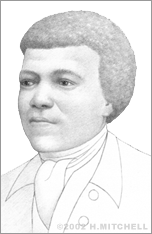Benjamin Banneker
Benjamin Banneker, one of the nation's best-known African American inventors, was born on November 9, 1731 in Maryland, which was then a British colony. His grandmother was white — an indentured servant from England — who later bought a farm in Maryland and married a former slave. Their daughter Mary married a former slave as well. His name was Robert Bannaky. Mary and Robert had several children, including Benjamin. Young Bannaky's grandmother taught him to read, and later he attended a local school where the schoolmaster changed Bannaky to Banneker. He grew up on the family farm where he worked hard and learned irrigation. The family was very successful in raising tobacco crops, even during dry spells.
In 1753, Banneker was inspired to build his own clock after an acquaintance of his gave him a watch. Banneker took the watch apart to find out how it worked and made drawings of each component. Based on his drawings, he carved larger versions of the components out of wood and constructed a clock that kept accurate time for more than 50 years. His work on the clock resulted in many requests for his expertise in repairing watches, clocks, and sundials.
Banneker continued to live and work on his family farm in Maryland, and when his parents died, they left the property to him. In 1771, a family by the name of the Ellicotts moved in next door, and Banneker became close friends with the Ellicott brothers, who lent him books on astronomy and math, as well as astronomical instruments. Banneker taught himself advanced math and began studying the stars. He made astronomical and tide calculations and weather predictions for yearly almanacs, which he published from 1792 to 1797. He did all the calculations himself. Banneker's almanacs were compared favorable to Benjamin Franklin's Poor Richards's Almanac. Banneker stopped publishing his almanac, however, due to poor sales.

Nevertheless, the almanacs won Banneker fame as far away as Europe. He used his reputation to promote social change, namely, to eliminate racism and war. He sent a copy of his first almanac to Secretary of State Thomas Jefferson with a letter protesting that the man who declared that "all men are created equal" owned slaves. Jefferson responded with enthusiastic words, but no political reform. Similarly, Banneker's attempts "to inspire a veneration for human life and a horror for war" fell mainly on deaf ears.
Meanwhile, in 1791, a cousin of one of Banneker's neighbors, Major Andrew Ellicott, asked Banneker to help him survey the "Federal Territory," now Washington, D.C. Banneker became one of three surveyors appointed by President George Washington. Architect Pierre L'Enfant had been assigned the job of planning the city, but he was later dismissed from the project. When he left, he took the plans with him. Banneker recreated the plans in two days, including a complete layout of the streets, parks, and major buildings. Thus, the city of Washington, D.C. itself is somewhat of a tribute to Banneker's memory.
Banneker died in 1806 at the age of 74. The U.S. Postal Service issued a postage stamp in his honor in 1980. In 1981, Benjamin Banneker Academic High School, a Washington D.C. college preparatory high school, opened and was named in his honor.


